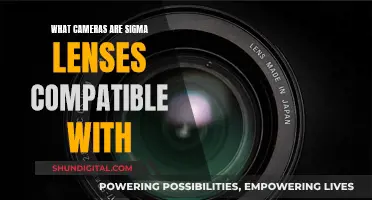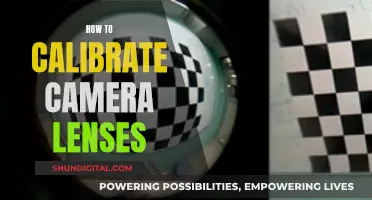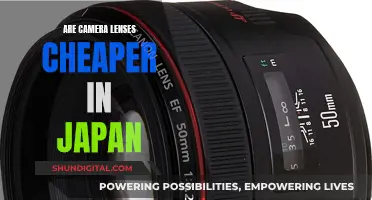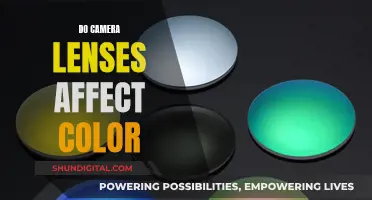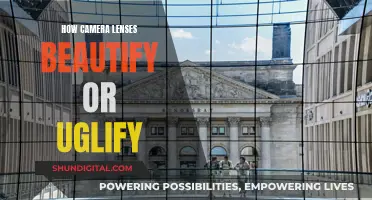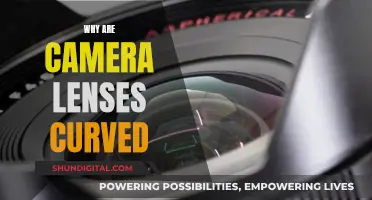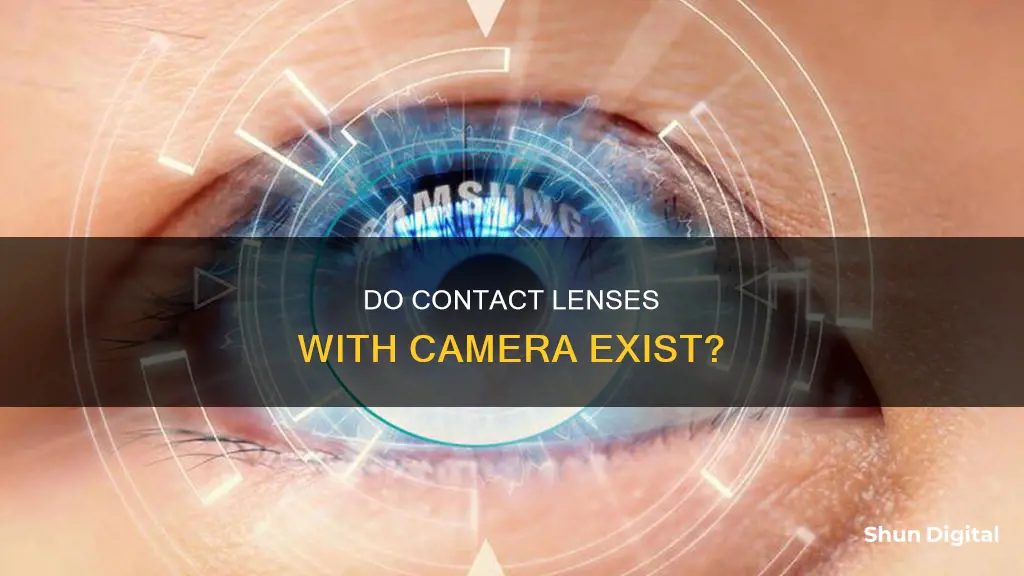
Smart contact lenses are no longer a futuristic concept. In fact, several companies are already researching and developing applications for smart contact lens technology, which has the potential to revolutionise not only how we see the world but also how the world sees us. From capturing images and videos to monitoring vital health parameters, the possibilities of smart contact lenses are endless. But how far are we from this futuristic reality?
| Characteristics | Values |
|---|---|
| Purpose | To improve vision, for cosmetic or therapeutic reasons |
| Control | Wearer's blinking |
| Power Source | Solar power sensors, piezoelectric sensors |
| Companies Involved | Sony, Samsung, Google, University of Wisconsin, University of Michigan, Swiss Federated Institute of Technology in Lausanne, Verily, Medella Health, Innovega |
What You'll Learn

Camera contact lenses and their applications
Camera contact lenses are no longer a thing of science fiction. In recent years, several companies have been working on smart contact lenses with a built-in camera. These lenses can do everything from recording video to monitoring the wearer's health. While the technology is still in development and not yet available on the market, it has a wide range of potential applications.
Health Monitoring
Smart contact lenses with a camera can be used to monitor the wearer's health and keep their entire body in better health. For example, these lenses can be used to track the progress of glaucoma or measure glucose levels in the eye fluids of patients with diabetes. They can also be programmed to release allergy-relief medication.
Augmented Reality and Virtual Reality
Camera contact lenses can be used to project virtual objects or video directly onto the wearer's eye, blurring the line between the physical and digital worlds. This has applications in entertainment, such as gaming, and can also be used for industrial, military, and security purposes.
Facial Recognition and Early Warning Systems
With a camera that follows the wearer's gaze, these contact lenses can be used for facial recognition and early warning systems. For example, the camera could spot a hazard and warn the wearer before their brain does, or it could be used by police to identify criminal faces in a crowd.
Bionic Eye
One of the most exciting applications of camera contact lenses is the possibility of creating a bionic eye system for blind and visually impaired people. This could give them the ability to see and interact with the world in a whole new way.
Social Norms and Privacy Concerns
While camera contact lenses have a wide range of potential benefits, they also raise concerns about social norms and privacy. If these lenses become mainstream, people may worry that they are being recorded at all times, leading to a sense of unease and suspicion. New legislation will likely be required to address these concerns.
CCD Camera Lenses: Color Corrected or Not?
You may want to see also

How camera contact lenses work
Camera contact lenses are in development and may be the next frontier for augmented reality (AR) and virtual reality (VR). Patents have been filed by tech giants and mixed-reality innovators for technologies that allow contact lenses to project virtual objects or video directly onto the wearer's eye.
The lenses are controlled by the wearer's blinking, with inventors saying that the lens will be able to tell the difference between involuntary and intentional blinking. The control will distinguish natural blinking from deliberate blinking by measuring the duration of the blink. A deliberate blink has a longer duration than an involuntary blink.
The Sony camera contact lens, for example, comprises a camera, on-board memory, a camera controller, wireless data transmission, and wireless power. The proposed camera will be triggered by monitoring blinking.
The Zoom Contact Lens, developed by scientists at the University of Southern California San Diego, is another example. This lens changes focal length when triggered by tiny electrical signals caused when the wearer blinks. By blinking twice, the lens, made from electro-active polymer films, can instantly change shape.
The smart contact lenses that reach the market are likely to contain micro-versions of the following technologies:
- Task-specific sensors
- Solar power sensors, to convert light to electrical power
- Piezoelectric sensors, to convert the mechanical eye movement of blinking into electrical power
Cameras and Lenses: Capturing the 3D World
You may want to see also

Companies developing camera contact lenses
Camera contact lenses are not just a thing of science fiction. Several companies are working on developing this technology and have filed patents for it.
Samsung
Samsung has been granted a patent in South Korea for smart contact lenses with a built-in camera. The lenses are also equipped with sensors and can be controlled by blinking. The content is sent to a smartphone through embedded antennas for processing.
Google owns two patents for smart contact lenses with flexible electronics and sensors. Google's contact lenses are mainly intended for medical use, with the ability to read tear fluid chemicals to determine blood sugar levels.
Sony
Sony has proposed a contact lens that comprises a camera, on-board memory, a camera controller, wireless data transmission, and wireless power. The patent also includes provision for a display. The camera will be triggered by monitoring blinking, distinguishing between natural and deliberate blinking by measuring the duration of the blink.
University of Southern California San Diego
Scientists at the University of Southern California San Diego have developed a biomimetic soft zoom contact lens that changes focal length when triggered by tiny electrical signals caused when the wearer blinks. The technology is currently too large to be worn in the eye and requires the user to wear electrodes on their face.
University of Wisconsin
The University of Wisconsin is working on a lens that uses light sensors and tiny power sources to autofocus on whatever the wearer is looking at.
University of Michigan
The University of Michigan is working on a lens that contains thermal imaging technology, giving the wearer night vision.
Cleaning Camera Lenses: A Step-by-Step Guide
You may want to see also

Camera contact lenses and privacy concerns
Camera contact lenses are no longer a futuristic concept. They are currently being developed by tech giants such as Google, Samsung, and Sony, as well as by researchers at universities like the University of Michigan and the University of Wisconsin. These lenses have built-in cameras and sensors that can record video and take photos, as well as provide health monitoring capabilities. While these lenses have a wide range of potential applications, they also raise significant privacy and security concerns.
One of the main privacy concerns with camera contact lenses is the potential for clandestine photography and surveillance. Unlike smart glasses, such as Google Glass, these lenses would be virtually undetectable, making privacy in public and semi-public places nearly impossible. This could lead to unconsented recordings of intimate interactions, violations of stalking laws, and covert surveillance of private meetings. Additionally, the data collected by these lenses could be susceptible to hacking, involuntary use, or malfunction.
The use of camera contact lenses by law enforcement and government agencies is another area of concern. While body-worn cameras by police officers has been a topic of discussion, the covert nature of camera contact lenses could add a new dimension to the debate. It raises questions about the appropriate use of this technology by law enforcement and the potential for government surveillance of its citizens.
Furthermore, the integration of facial recognition technology with camera contact lenses could exacerbate privacy concerns. This technology, combined with databases containing photos from social media, has already been used by law enforcement agencies and raises questions about the balance between public safety and individual privacy.
Another issue to consider is the impact of camera contact lenses on social norms and interactions. If these lenses become widespread, people may worry that they are being recorded at all times, leading to a potential shift in social behaviour. Additionally, the ability to secretly run searches or access information about someone during a conversation could distort perceptions of in-person intimacy and connection.
To address these privacy concerns, new legislation will likely be required. Regulations will need to be put in place to govern the use of camera contact lenses and the data they collect. This includes considerations for data security, consent, and the appropriate use of the technology by individuals and organizations.
In conclusion, while camera contact lenses offer exciting possibilities, they also present complex privacy and security challenges that need to be carefully navigated to protect the rights and well-being of individuals in an increasingly technologically advanced world.
Camera Lenses: Is Price Tag Directly Linked to Quality?
You may want to see also

Camera contact lenses and the future of AR/VR
The idea of smart contact lenses is no longer a futuristic concept. In fact, several companies are actively researching and developing this technology, with the smart contact lens market expected to grow by 10.4% by 2023. While the idea of a contact lens that can record video or take photographs may seem far-fetched, it is important to note that the underlying technology already exists and is continuously being improved.
Current State of Smart Contact Lenses
At the moment, smart contact lenses are still in the development and testing phases, with companies such as Sony, Samsung, and Google leading the way. These lenses are designed to be worn like regular contact lenses and do not require surgery. They contain miniaturized versions of existing technology, such as sensors, cameras, and wireless chips. One of the main challenges in creating smart contact lenses is powering the electronics. Researchers are exploring the use of solar power sensors and piezoelectric sensors that convert blinking or eye movement into electrical energy.
Potential Applications in AR/VR
The potential applications of smart contact lenses in the fields of augmented reality (AR) and virtual reality (VR) are vast. For example, Samsung has been granted a patent for smart contact lenses that project images directly into the wearer's eyes, creating an AR experience. On the other hand, Google has patented smart contact lenses with flexible electronics and sensors that can monitor an individual's health, such as blood sugar levels, by analyzing tear fluid. These health monitoring capabilities could also be applied in the VR space, providing real-time feedback on vital signs during immersive VR experiences.
Benefits and Concerns
Smart contact lenses offer several advantages over traditional AR/VR headsets, including increased discretion, improved comfort, and enhanced social interactions. However, there are also concerns regarding privacy, data security, and social norms. The always-on recording capability of these lenses could potentially change social interactions and norms, as people may worry about being recorded at all times. Additionally, new legislation and regulations will be required to address the potential misuse of this technology.
Smart contact lenses have the potential to revolutionize the way we interact with technology, particularly in the fields of AR and VR. While there are still technical challenges to be overcome and ethical considerations to be made, the future of smart contact lenses looks promising. As companies continue to innovate and develop this technology, we can expect to see a shift in how we experience the world through augmented and virtual reality.
Q-See Camera Lenses: Plastic or Glass?
You may want to see also
Frequently asked questions
Yes, camera contact lenses exist and are currently being developed by companies such as Sony and Samsung. These lenses can take pictures and record videos, controlled by the wearer's blinking.
Camera contact lenses have a wide range of applications, from entertainment to policing, military operations, and medical use. They can be used to monitor symptoms for patients with long-term illnesses and provide surgeons with enhanced vision and immediate feedback on vital signs.
While the technology is not yet market-ready, it is expected that smart contact lenses will gain widespread adoption in the future, with the market expected to see a compound annual growth rate of 10.4% by 2023.


